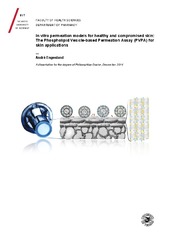In vitro permeation models for healthy and compromised skin: The Phospholipid Vesicle-based Permeation Assay (PVPA) for skin applications
Permanent link
https://hdl.handle.net/10037/9065View/
thesis introduction (PDF)
Engesland André, Skar Merete, Hansen Terkel, Škalko-Basnet Nataša, Flaten Gøril Eide.: "New applications of phospholipid vesicle-based permeation assay: permeation model mimicking skin barrier". Also available in Journal of Pharmaceutical Sciences, 2013, 102(5) (PDF)
Zora Palac, André Engesland, Gøril Eide Flaten, Nataša Škalko-Basnet, Jelena Filipović- Grčić, Željka Vanić. Liposomes for (trans)dermal drug delivery: the skin-PVPA as a novel in vitro stratum corneum model in formulation development. Also available in Journal of liposome research, 2014; 24(4): 313–322 (PDF)
Engesland André, Škalko-Basnet Nataša, Flaten Gøril Eide.: "PVPA and EpiSkin® in assessment of drug therapies destined for skin administration" (2014). (Accepted manuscript). Later published as "Phospholipid vesicle-based permeation assay and EpiSkin® in assessment of drug therapies destined for skin administration", and available in Journal of Pharmaceutical Sciences, 2015, 104(3) (PDF)
Date
2015-03-20Type
Doctoral thesisDoktorgradsavhandling
Author
Engesland, AndréAbstract
In vitro models with the ability to estimate drug penetration through healthy and compromised skin may reduce animal testing of drugs and cosmetics to a minimum. The phospholipid vesicle based permeation assay (PVPA) is based on a tight barrier composed of liposomes mimicking cells. It was originally made to mimic the intestinal epithelial barrier and in this project further developed to mimic the stratum corneum barrier of the skin. The lipid composition was changed to better mimic the lipid composition of skin and new preparation methods of the barriers were developed.
The performance of two new skin mimicking PVPA models was evaluated by assessing the permeation of eight drugs. The two models developed in this study
the PVPAs (E-80/ceramide/cholesterol/palmitic acid/cholesteryl sulphate) and PVPAc (E-80/cholesterol) appeared to distinguish between drugs of high and low penetration potential when compared with permeation data from animal skin and the reconstructed human skin, EpiSkin® as well as calculated data.
Moreover, the PVPA models mimicking skin were also applied to evaluate the penetration potential of a drug in different liposomal formulations. The permeation of drugs from liposomal formulations was significantly enhanced as compared to the drugs in solution form and was able to distinguish between carriers with different physicochemical properties. Encouraged by the results from previous experiments, different drugs and drugs in liposomal formulations were tested in the PVPAs and PVPAc models and the permeability results were compared with the results for the reconstructed human skin model, EpiSkin®. The results were in accordance with what was expected considering the physicochemical properties.
Finally, PVPA barriers mimicking a compromised skin barrier (accompanying skin disorders or skin damage) were developed. Two approaches were applied to prepare barriers with lower barrier function. First, by adjusting the concentration of ethanol used to fuse liposomes, thus controlling the tightness; second, reducing the thickness of the liposome layer. Results from the PVPA models demonstrated reliable increased permeation with the increased ethanol content and the decreased barrier thickness.
Description
Paper IV of this thesis is not available in Munin:
Engesland André ... et al. : "Phospholipid vesicle-based permeation assay (PVPA) as in vitro models for the compromised skin barrier" (Manuscript). Revised published version with title "In vitro models to estimate drug penetration through the compromised stratum corneum barrier" available in Drug Development and Industrial Pharmacy, Vol. 42, No. 11, p. 1742–1751 (2016)
Engesland André ... et al. : "Phospholipid vesicle-based permeation assay (PVPA) as in vitro models for the compromised skin barrier" (Manuscript). Revised published version with title "In vitro models to estimate drug penetration through the compromised stratum corneum barrier" available in Drug Development and Industrial Pharmacy, Vol. 42, No. 11, p. 1742–1751 (2016)
Publisher
UiT Norges arktiske universitetUiT The Arctic University of Norway
Metadata
Show full item recordCollections
Copyright 2015 The Author(s)
The following license file are associated with this item:


 English
English norsk
norsk
